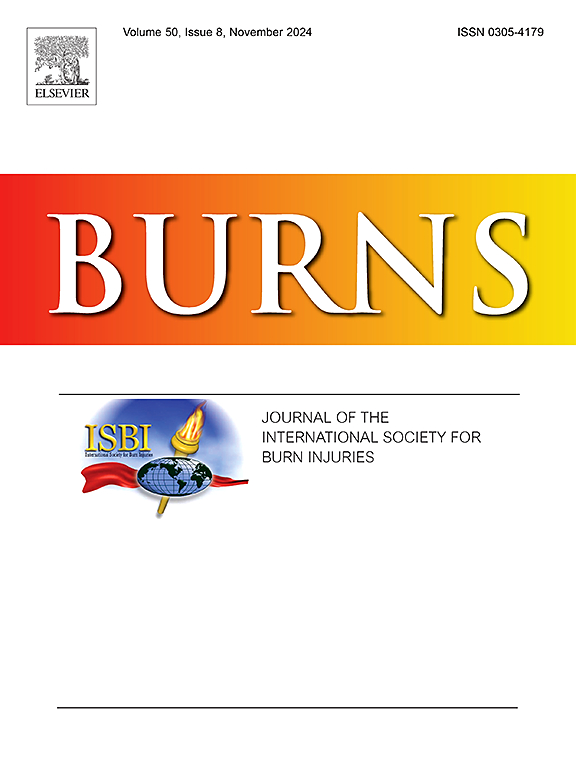可喷涂自体表皮细胞促进糖尿病患者全层皮肤创面愈合的实验研究
IF 2.9
3区 医学
Q2 CRITICAL CARE MEDICINE
引用次数: 0
摘要
自体表皮细胞喷雾技术在促进表皮再生和治疗慢性难治性伤口方面已被证明是有效的。然而,其对糖尿病伤口愈合的潜在影响仍然知之甚少。该研究旨在通过分析伤口愈合的关键方面,包括再上皮化、血管生成、炎症和细胞外基质重塑,来评估这种创新疗法的有效性。用链脲佐菌素注射诱导五指山猪糖尿病。然后在猪身上制造全层伤口,随机分为两组(每组 = 8只):实验组使用可喷涂的自体表皮细胞治疗,对照组不进行治疗。结果表明,可喷自体表皮细胞治疗的创面完全愈合率显著提高(100.0 % vs. 86.9 ± 5.3 %;p & lt; 0.05)。组织学分析实验组显示愈合较厚表皮( 87.0±10.5μm和70.3 ± 9.2μm, p & lt; 0.001)和更长的网脊(7.8 ± 0.89 vs 5.5 ± 每毫米1.1,p & lt; 0.01)相比,对照组术后21天。进一步分析表明,与对照组相比,实验组的炎症细胞因子表达和细胞外基质沉积减少。此外,实验组表现出新血管形成,周细胞覆盖,细胞增殖标志物和生长因子表达的增加。因此,这项小样本量的研究表明,可喷涂的自体表皮细胞疗法可能会加速糖尿病伤口愈合,在更大规模的研究中具有更广泛的临床应用潜力。本文章由计算机程序翻译,如有差异,请以英文原文为准。
Experimental study on sprayable autologous epidermal cells for promoting full-thickness skin wound healing in diabetes
The technology of sprayable autologous epidermal cells has been proven effective in promoting epidermal regeneration and healing chronic refractory wounds. However, its underlying impact in diabetic wound healing remains less understood. The research aims to evaluate the effectiveness of this innovative therapy by analyzing key aspects of wound healing, including re-epithelialization, angiogenesis, inflammation, and extracellular matrix remodeling. Diabetes was induced in Wuzhishan pigs using streptozotocin injection. Full-thickness wounds were then created on the pigs, which were randomly assigned to two groups (n = 8 per group): the experimental group was treated with sprayable autologous epidermal cells, while the control group received no treatment. The findings indicated that wounds treated with sprayable autologous epidermal cells exhibited a significantly improved rate of complete wound closure (100.0 % vs. 86.9 ± 5.3 %; p < 0.05). Histological analysis of the experimental group revealed re-epithelialization with thicker epidermis (87.0 ± 10.5 μm vs. 70.3 ± 9.2 μm, p < 0.001)and longer rete ridges (7.8 ± 0.89 vs. 5.5 ± 1.1 per mm, p < 0.01) compared to the control group on postoperative day 21. Further analysis demonstrated decreases in inflammatory cytokine expression and extracellular matrix deposition in the experimental group compared to the control group. Additionally, the experimental group exhibited increases in new blood vessel formation, pericyte coverage, cell proliferation markers, and growth factor expression. Therefore, this small sample size study suggests that sprayable autologous epidermal cell therapy may accelerate diabetic wound healing, with potential for broader clinical application in larger studies.
求助全文
通过发布文献求助,成功后即可免费获取论文全文。
去求助
来源期刊

Burns
医学-皮肤病学
CiteScore
4.50
自引率
18.50%
发文量
304
审稿时长
72 days
期刊介绍:
Burns aims to foster the exchange of information among all engaged in preventing and treating the effects of burns. The journal focuses on clinical, scientific and social aspects of these injuries and covers the prevention of the injury, the epidemiology of such injuries and all aspects of treatment including development of new techniques and technologies and verification of existing ones. Regular features include clinical and scientific papers, state of the art reviews and descriptions of burn-care in practice.
Topics covered by Burns include: the effects of smoke on man and animals, their tissues and cells; the responses to and treatment of patients and animals with chemical injuries to the skin; the biological and clinical effects of cold injuries; surgical techniques which are, or may be relevant to the treatment of burned patients during the acute or reconstructive phase following injury; well controlled laboratory studies of the effectiveness of anti-microbial agents on infection and new materials on scarring and healing; inflammatory responses to injury, effectiveness of related agents and other compounds used to modify the physiological and cellular responses to the injury; experimental studies of burns and the outcome of burn wound healing; regenerative medicine concerning the skin.
 求助内容:
求助内容: 应助结果提醒方式:
应助结果提醒方式:


